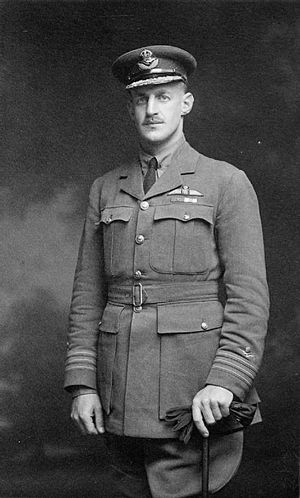Additions will be checked before being published on the website and where possible will be forwarded to the person who submitted the original entries. Your contact details will not be forwarded, but they can send a reply via this messaging system.
please scroll down to send a message
Gp Capt. Lionel Wilmot Brabazon Rees VC MC MID
Royal Air Force 11 Squadron
from:Plas Llanwnda, Castle Street, Caernarfon
Lionel Rees was born in Plas Llanwnda, Castle Street, Caernarfon in 1884. Rees attended Eastbourne College before entering the Royal Military Academy at Woolwich. He was commissioned in 1903 with the Royal Garrison Artillery. In 1912 he learned to fly at his own expense, receiving his Aviator's Certificate (no. 392) in January 1913. By 1913-14 Rees was attached to the West African Frontier Force when he was seconded to the Royal Flying Corps in August 1914, initially as an instructor at Upavon. He first saw action flying the Vickers Gunbus with No. 11 Squadron RFC in the summer of 1915, earning a reputation as an aggressive pilot and an above average marksman.
Rees was awarded the Military Cross for his actions in 1915, gazetted as follows:
For conspicuous gallantry and skill on several occasions, notably the following: On 21st September, 1915, when flying a machine with one machine gun, accompanied by Flight-Serjeant Hargreaves, he sighted a large German biplane with two machine guns 2,000 feet below him. He spiralled down and dived at the enemy, who, having the faster machine, manoeuvred to get him broadside on and then opened heavy fire. Despite this, Captain Rees pressed his attack and apparently succeeded in hitting the enemy's engine, for the machine made a quick turn, glided some distance and finally fell just inside the German lines near Herbecourt.
On 28 July he attacked and drove down a hostile monoplane despite the main spar of his machine having been shot through and the rear spar shattered. On 31 August, accompanied by Flight-Sergeant Hargreaves, he fought a German machine more powerful than his own for three-quarters of an hour, then returned for more ammunition and went out to the attack again, finally bringing the enemy's machine down apparently wrecked. By this time he had claimed 1 aircraft captured, 1 destroyed, 1 'forced to land' and 5 'driven down'.
Rees was 31 years old and a Temporary Major in No. 32 Squadron RFC, when the following deed took place for which he was awarded the VC.
In the first hours of the Somme Offensive, Rees was on patrol, taking off in Airco DH.2 No. 6015 at 0555 hours. His attempt to join a formation of "British" machines brought an attack from one of the Germans. He shot up the attacker, hitting its fuselage between the two aircrew. As it dove away, Rees attacked a Roland. Long range fire from three other Germans did not discourage Rees from closing on it; it emitted a hazy cloud of smoke from its engine from the 30 rounds Rees pumped into it, and it fled. Rees then single handedly went after five more Germans. A bullet in the thigh paralysed his leg, forcing him to break off his assault. As the shock of the wound wore off, he was able to pursue the German formation leader, which was leaving after dropping its bomb. He fired his Lewis machine gun empty. In frustration, he drew his pistol but dropped it into his DH.2's nacelle. Meanwhile, the German two-seater pulled away above him. The German formation was shattered and scattered. Rees gave up the futile chase, and returned to base. Once landed, he calmly asked for steps so he could deplane. Once seated on the aerodrome grass, he had a tender fetched to take him to hospital. The valor of his actions earned him the Victoria Cross.
The citation reads: On 1st July 1916 at Double Crassieurs, France, Major Rees, whilst on flying duties, sighted what he thought was a bombing party of our machines returning home, but were in fact enemy aircraft. Major Rees was attacked by one of them, but after a short encounter it disappeared, damaged. The others then attacked him at long range, but he dispersed them, seriously damaging two of the machines. He chased two others but was wounded in the thigh, temporarily losing control of his aircraft. He righted it and closed with the enemy, using up all his ammunition, firing at very close range. He then returned home, landing his aircraft safely.
For the remainder of the war Rees commanded the Air Fighting School at Ayr.
Additional Information:
